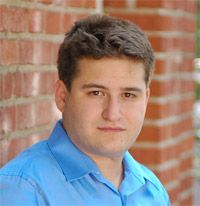Professor Michael Hochberg
The Seattle Post-Intelligencer article UW scientists part of breakthrough in optical nanotechnology said
“The goal of using light particles, photons, rather than clumsy old electrons to improve upon — and further miniaturize — all manner of computers and electronic devices appears a step closer to reality thanks to researchers in Seattle and at Yale University.‘We got started on this to see how we could use light to actuate (move) objects,’ said Michael Hochberg, a University of Washington assistant professor of electrical engineering and expert in the field of optical nanotechnology.
In Thursday’s edition of the journal Nature, Hochberg and UW colleague Thomas Baehr-Jones are credited with designing an optical device that represents an entirely new way to do just that. The project, led by Yale electrical engineers Mo Li and Hong Tang, was heralded by the editors at Nature as a significant milestone in the field of photonics.”
Michael Hochberg, Ph.D. is Assistant Professor of Electrical Engineering, University of Washington. His research interests include silicon photonics, nonlinear optics, and ultra-low drive voltage optical modulators.
Michael earned his BS (Physics, 2002), his MS (Applied Physics, 2005) and his PhD (Applied Physics, 2006) from Caltech, and he was awarded the Demetriades-Tsafka Prize in Nanotechnology for the best dissertation by a graduating Ph.D. student in the field of Nanotechnology.
As an undergraduate, he cofounded two companies: Simulant, which sold the first commercial distributed Finite-Difference Time Domain (FDTD) code, and Luxtera, a venture-funded company working to commercialize silicon photonics. As a graduate student, he worked on developing integrated nonlinear optical devices using silicon photonics. He was also the recipient of an NSF Graduate Research Fellowship and, as an undergraduate, of a merit-based fellowship from Caltech.
Michael coauthored All Optical Modulation in a Silicon Waveguide Based on a Single-Photon Process, Polymer Silicon Hybrid Systems: a Platform for Practical Nonlinear Optics, Nonlinear polymer-clad silicon slot waveguide modulator with a half wave voltage of 0.25 V, Photodetection in silicon beyond the band edge with surface states, Design of a tunable, room temperature, continuous-wave terahertz source and detector using silicon waveguides, Design and fabrication of segmented, slotted waveguides for electro-optic modulation, Towards a millivolt optical modulator with nano-slot waveguides, and Terahertz all-optical modulation in silicon-polymer hybrid system. Read the full list of his publications!
Michael recently joined the faculty at the University of Washington in Electrical Engineering, where he was the recipient of a 2007 Air Force Office of Sponsored Research Young Investigators Program award.
